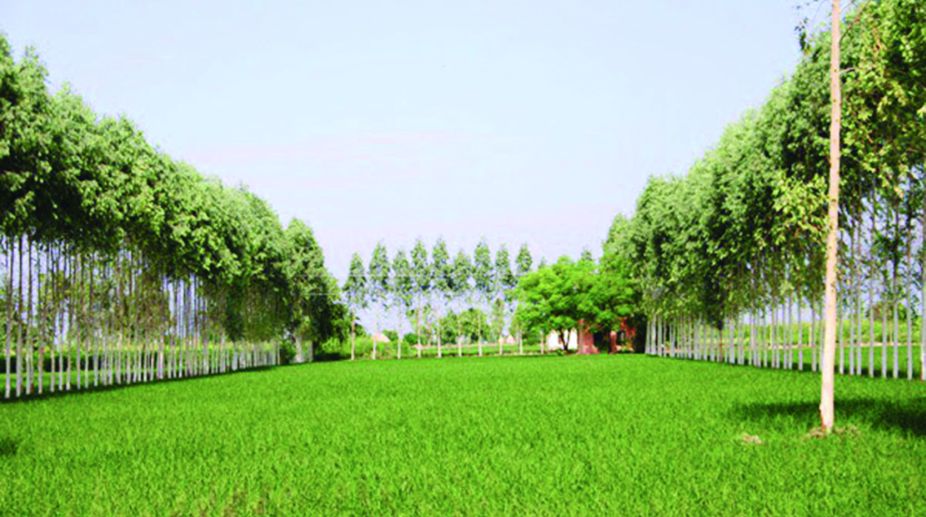Haryana Govt is committed to improving the standard of people’s living: CM
Haryana Chief Minister Nayab Singh Saini on Sunday said that development works are being carried out across Haryana with a focus inclusive on progress.

With an aim to bring more forest and tree cover over the state’s geographical area in a phased manner, Haryana’s Forest Department has laid special emphasis on “agroforestry” to enable this forest- deficient state to support a large number of wood-based industries based on farm-grown wood.
The department has been distributing 2.5 crore seedlings every year to the farmers and other tree growers free to promote agro-forestry. Recently, the department decided to sell the seedlings at subsidised cost so that more farmers could adopt the agroforestry for economic and ecological prosperity as they can earn more by combining agriculture and forestry.
Advertisement
The state’s forest department believes that agro-forestry is an answer to bridge the gap between the demand and supply of fuel wood, fodder, timber and to reduce pressure on forests by meeting these demands outside the forests area.
Advertisement
A senior Indian Forest Service (IFS) officer said agroforestry also helps in mitigating global warming and climate change by sequestering the carbon, as fast growing species are preferred under agro-forestry systems.
He said, “Agroforestry is an area wherein Haryana has taken long strides. This is the only way in which the state can increase its area under green cover. Besides, agroforestry is one way farmers can get the most use out of their land and make more money taking advantage of wood-based industries in the state.
“The town of Yamunanagar has virtually become the national centre of plywood and veneer industry. Our policy of not having any restrictions on felling of trees from private areas and on transit of wood, has also helped in expanding the timber trade and wood-based industries. Our endeavour is to create favourable conditions so that wood-based industries and agroforestry activity can grow simultaneously. The state government is also establishing an organised timber market at Yamunanagar district to facilitate transparent trade of farm-grown wood,” he said.
The official said, ” Our endeavour is to involve rural people, especially women, in raising forest nurseries so that agro-forestry can become a people’s movement. Agroforestry is the most economical, sustainable and stable alternative for ecological security of land production system. Whereas the average productivity of plantations in forest and wastelands is approximately four to five cubic metres per hectare per year, seed-route agroforestry plantations in irrigated land ensure average productivity of 10 to 15 cubic metres per hectare. The average productivity has been enhanced to 25 to 30 cubic meters per hectare per year from poplar and clonal eucalyptus plantations. Thus, by all aspects, agroforestry is a cheap, profitable and sustainable alternative.”
There is vast scope for research and development (R&D) in the field of agroforestry. Many high-yielding clones of agroforestry species have been evolved which need to be demonstrated in the field, so that tree growers can increase productivity of their plantations. High-yielding and disease-resistant clones of eucalyptus, poplar, teak, Ailanthus, Khejri and many others need to be evolved through continuous research, he added.
He said, “It will not be wrong to say that efforts made by Haryana Forest Department for the progress of agro-forestry are among the best in the country. Furthermore, the farmers of Haryana state have adopted this income generation system as an inseparable part of their farmers’ practices. Haryana has both wet and arid regions and accordingly both rain-fed and irrigated agriculture is practiced by the farmers. Consequently, many suitable agro-forestry models have been developed by the Forest Department, while some others have been evolved by farmers through practical exposure.”
The Forest Department believes the major objective of agro-forestry is to optimise production and economic returns per unit area, while respecting the principle of sustainable development. In order to attain this objective, certain agro-forestry models have been evolved and standardised, combining optimum land use system with tree-agriculture-livestock production system to give maximum economic returns, simultaneously or sequentially. However, the models have to be designed in such a manner so as to make them technologically feasible, ecologically sustainable, economically viable and socially acceptable.
In Haryana, except, Shivalik and Aravalli regions there are no restrictions on planting, felling, transportation and sale of trees planted on farm lands. Poplar and Eucalyptus have been the two most popular species for agroforestry in the state.
Poplar planting also helps in protecting agricultural crops from scorching sun, desiccating effect of wind and controls soil erosion. The fertile soil and high water table have been found quite favourable for raising poplar plantations.
Eucalyptus has been grown along with agricultural crops since the sixties, as wind break, as avenue trees on farmers homesteads, cattlesheds and on farm approach roads. Raising of eucalyptus on field boundaries under different patterns of planting, is a common practice adopted by farmers. It has been observed that eucalyptus plant is beneficial to the associated crop.
Advertisement